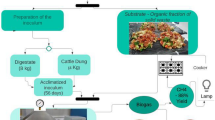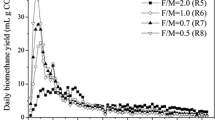Abstract
The combined anaerobic fermentation experiment of the waste mushroom substrate and food waste was carried out at 37 ± 1℃ in this study, and the gas production, pH, soluble chemical oxygen demand concentration, ammonia nitrogen concentration, total volatile fatty acids concentration, main hydrolase activities and other parameters were measured within 60 days. The results showed that when the mixing ratio of the waste mushroom substrate and food waste was 1:1, the anaerobic fermentation gas production was the highest (10628 mL), which was 43.4% and 31.9% higher than that of pure waste mushroom substrate and food waste, respectively. The gas production stage lasted for up to 30 days, and the system could run stably without artificial regulation. Netlogo simulation was used to verify that changing the nutrient structure of fermentation substrate could keep the number of microorganisms at a high level for a long time. This study provides the material ratio and corresponding anaerobic fermentation reaction parameters for large-scale biogas engineering, and conducts NETLOGO simulation to explore the influence rule of material ratio on gas production, which can avoid some problems in practical engineering.













Similar content being viewed by others
References
Cheng XY, LIU C Z, (2012) Enhanced coproduction of hydrogen and methane from cornstalks by a three-stage anaerobic fermentation process integrated with alkaline hydrolysis [J]. Biores Technol 104:373–379. https://doi.org/10.1016/j.biortech.2011.10.082
Zhang B, HE P J, (2014) Performance assessment of two-stage anaerobic digestion of kitchen wastes [J]. Environ Technol 35(10):1277–1285. https://doi.org/10.1080/09593330.2013.866169
Wu MK, Hu JG, Shen F et al (2021) Conceptually integrating a multi-product strategy for the valorization of kitchen waste towards a more sustainable management [J]. J Clean Prod. https://doi.org/10.1016/j.jclepro.2021.127292
Micolucci F, Gottardo M, Bolzonella D et al (2020) Pilot-scale multi-purposes approach for volatile fatty acid production, hydrogen and methane from an automatic controlled anaerobic process [J]. J Clean Prod. https://doi.org/10.1016/j.jclepro.2020.124297
Zhao ZQ, Li Y, Zhang YB et al (2020) Sparking anaerobic digestion: promoting direct interspecies electron transfer to enhance methane production [J]. Iscience. https://doi.org/10.1016/j.isci.2020.101794
Ingersoll JG (2020) Thermophilic co-fermentation of wood wastes and high in nitrogen animal manures into bio-methane with the aid of fungi and its potential in the USA [J]. Energies. https://doi.org/10.3390/en13164257
Jiang JF, Li LH, Cui MC et al (2018) Anaerobic digestion of kitchen waste: The effects of source, concentration, and temperature [J]. Biochem ENG J 135:91–97. https://doi.org/10.1016/j.bej.2018.04.004
Pecar D, Gors A (2020) Kinetics of methane production during anaerobic digestion of chicken manure with sawdust and miscanthus [J]. Biomass Bioenerg. https://doi.org/10.1016/j.biombioe.2020.105820
You ZY, Pan SY, Sun N et al (2019) Enhanced corn-stover fermentation for biogas production by NaOH pretreatment with CaO additive and ultrasound [J]. J Clean Prod. https://doi.org/10.1016/j.jclepro.2019.117813
Zhang F, Yu W, Liu WH et al (2020) The mixed fermentation technology of solid wastes of agricultural biomass [J]. F Energy Res. https://doi.org/10.3389/fenrg.2020.00050
Cabrera F, Serrano A, Torres A et al (2019) The accumulation of volatile fatty acids and phenols through a pH controlled fermentation of olive mill solid waste [J]. Sci Total Environ 657:1501–1507. https://doi.org/10.1016/j.scitotenv.2018.12.124
Colmenarejo MF, Sanchez E, Bustos A et al (2004) Pilot-scale study of total volatile fatty acids production by anaerobic fermentation of sewage in fixed-bed and suspended biomass reactors [J]. Proc Biochem 39(10):1257–1267. https://doi.org/10.1016/s0032-9592(03)00253-x
Delgado L, Heckmann CM, di Pisa F et al (2021) Release of soybean isoflavones by using a beta-glucosidase from Alicyclobacillus herbarius [J]. ChemBioChem 22(7):1223–1231. https://doi.org/10.1002/cbic.202000688
Munda US, Pholane L, Kar DD et al (2012) Production of bioenergy from composite waste materials made of corn waste, spent tea waste, and kitchen waste co-mixed with cow dung [J]. I J Green Energ 9(4):361–375. https://doi.org/10.1080/15435075.2011.621492
Rodrigues CV, Alcaraz FAR, Nespeca MG et al (2020) Biohydrogen production in an integrated biosystem using crude glycerol from waste cooking oils [J]. Renewable Energy 162:701–711. https://doi.org/10.1016/j.renene.2020.08.061
Zhang Q, Lu Y, Zhou XN et al (2020) Effect of different vegetable wastes on the performance of volatile fatty acids production by anaerobic fermentation [J]. Sci Total Environ. https://doi.org/10.1016/j.scitotenv.2020.142390
Saha S, Basak B, Hwang JH et al (2020) Microbial Symbiosis: a network towards Biomethanation [J]. Trends Microbiol 28(12):968–984. https://doi.org/10.1016/j.tim.2020.03.012
Zielinska M, Cydzik-Kwiatkowska A, Zielinski M et al (2013) Impact of temperature, microwave radiation and organic loading rate on methanogenic community and biogas production during fermentation of dairy wastewater [J]. Biores Technol 129:308–314. https://doi.org/10.1016/j.biortech.2012.11.093
Liu ZD, Liu J, Li BM et al (2014) Focusing on the process diagnosis of anaerobic fermentation by a novel sensor system combining microbial fuel cell, gas flow meter and pH meter [J]. Int J Hydrogen Energy 39(25):13658–13664. https://doi.org/10.1016/j.ijhydene.2014.04.076
Isha A, D’ silva T C, Subbarao P M V, et al (2021) Stabilization of anaerobic digestion of kitchen wastes using protein-rich additives: Study of process performance, kinetic modelling and energy balance [J]. BIoresource Technol. https://doi.org/10.1016/j.biortech.2021.125331
Zhu SN, Zhang QG, Zhang ZP et al (2020) Performance evaluation of bio-hydrogen and bio-methane cogeneration from corn stover over a range of initial pH and temperature [J]. Int J Hydrogen Energy 45(41):21157–21165. https://doi.org/10.1016/j.ijhydene.2020.05.269
Ma XX, Yu M, Song N et al (2020) Effect of ethanol pre-fermentation on organic load rate and stability of semi-continuous anaerobic digestion of food waste [J]. Biores Technol. https://doi.org/10.1016/j.biortech.2019.122587
LIU J G, ZHAO S H, ZHANG L H. 2012 Study on Anaerobic Digestion Performance of Kitchen Wastes: inhibition of ammonia nitrogen and volatile acid on the anaerobic methanogenesis; proceedings of the International Conference on Energy, Environment and Sustainable Development (ICEESD 2011), Shanghai Univ Elect Power, Shanghai, PEOPLES R CHINA, F Oct 21–23, [C]..
Krakat N, Demirel B, Anjum R et al (2017) Methods of ammonia removal in anaerobic digestion: a review [J]. Water Sci Technol 76(8):1925–1938. https://doi.org/10.2166/wst.2017.406
Li MT, Rao L, Wang L et al (2022) Bioaugmentation with syntrophic volatile fatty acids-oxidizing consortia to alleviate the ammonia inhibition in continuously anaerobic digestion of municipal sludge [J]. Chemosphere. https://doi.org/10.1016/j.chemosphere.2021.132389
He C, Qi BY, Jiao YZ et al (2020) Potentials of bio-hydrogen and bio-methane production from diseased swines [J]. Int J Hydrogen Energy 45(59):34473–34482. https://doi.org/10.1016/j.ijhydene.2019.08.215
Jin Y, Lin YJ, Wang P et al (2019) Volatile fatty acids production from saccharification residue from food waste ethanol fermentation: effect of pH and microbial community [J]. Biores Technol. https://doi.org/10.1016/j.biortech.2019.121957
BRADBURY D, (1953) Division of starch-containing cells [J]. AM J BOT 40(4):286–288. https://doi.org/10.2307/2438669
Tampio E, Ervasti S, Paavola T et al (2014) Anaerobic digestion of autoclaved and untreated food waste [J]. Waste Manage 34(2):370–377. https://doi.org/10.1016/j.wasman.2013.10.024
MARKOU G, (2015) Improved anaerobic digestion performance and biogas production from poultry litter after lowering its nitrogen content [J]. Biores Technol 196:726–730. https://doi.org/10.1016/j.biortech.2015.07.067
Hartmann H, AHRING B K, (2005) A novel process configuration for anaerobic digestion of source-sorted household waste using hyper-thermophilic post-treatment [J]. Biotechnol Bioeng 90(7):830–837. https://doi.org/10.1002/bit.20485
Funding
The Key Research and Service Project of Liaoning Provincial Department of Education (JYT2020146).
Author information
Authors and Affiliations
Corresponding author
Ethics declarations
Conflict of interest
No conflict of interest exists amongst authors.
Additional information
Publisher's Note
Springer Nature remains neutral with regard to jurisdictional claims in published maps and institutional affiliations.
Rights and permissions
Springer Nature or its licensor (e.g. a society or other partner) holds exclusive rights to this article under a publishing agreement with the author(s) or other rightsholder(s); author self-archiving of the accepted manuscript version of this article is solely governed by the terms of such publishing agreement and applicable law.
About this article
Cite this article
Gu, H., Feng, L. & Zhen, X. Study on the stability of anaerobic digestion of food waste and the waste mushroom substrate based on SBR reactor and Netlogo simulation. J Mater Cycles Waste Manag 25, 793–809 (2023). https://doi.org/10.1007/s10163-022-01559-7
Received:
Accepted:
Published:
Issue Date:
DOI: https://doi.org/10.1007/s10163-022-01559-7




